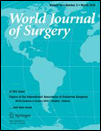Comparison of Bilateral Axillo-Breast Approach Robotic Thyroidectomy with Open Thyroidectomy for Graves’ Disease
Abstract
Background
There is an ongoing debate about whether robotic thyroidectomy (RT) is appropriate for Graves’ disease. The aim of this study was to compare the safety of bilateral axillo-breast approach (BABA) RT with that of open thyroidectomy (OT) in patients with Graves’ disease.
Methods
From January 2008 to June 2014, 189 (44 BABA RT and 145 OT) patients underwent total thyroidectomy for Graves’ disease. Recurrence of Graves’ disease, intraoperative blood loss, hospital stay, and complication rates including recurrent laryngeal nerve (RLN) palsy and hypoparathyroidism were analyzed between BABA RT and OT groups, after propensity score matching according to age, gender, body mass index, surgical indication, the extent of operation, excised thyroid weight, and follow-up period.
Results
No patient experienced recurrence of Graves’ disease after median follow-up of 35.0 months. Intraoperative blood loss (151.8 ± 165.4 mL vs. 134.5 ± 75.4 mL; p = 0.534) and hospital stay (3.4 ± 0.7 day vs. 3.3 ± 0.7 day; p = 0.564) were not different between BABA RT and OT groups. Complication rates including transient RLN palsy (11.4 vs. 11.4 %; p = 1.000), transient hypoparathyroidism (18.2 vs. 20.5 %; p = 0.787), permanent RLN palsy (0 vs. 2.3 %; p = 0.315), and permanent hypoparathyroidism (2.3 vs. 2.3 %; p = 1.000) were also comparable between groups.
Conclusions
BABA RT for Graves’ disease showed comparable surgical completeness and complications to conventional OT. BABA RT can be recommended as an alternative surgical option for patients with Graves’ disease who are concerned about cosmesis.




